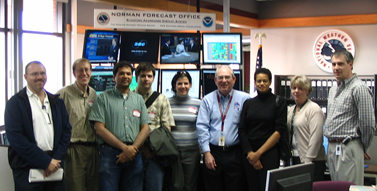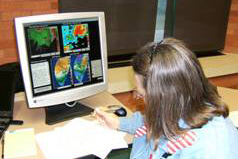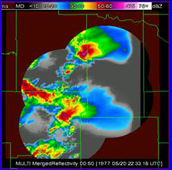End User Integration
The End User Integration (EUI) team incorporated user needs into system design and linked CASA's technology to individuals, organizations, and society at large. 
The EUI team interacted with users of weather data, such as the National Weather Service, private meteorology companies, academic researchers, and emergency managers. The team studied social, policy, behavioral, and technical interface issues around the use of DCAS systems in weather impacted decision making and response.
The goals of the EUI team focused on four interrelated areas:
- Specification of DCAS Adaptive Scanning Strategy
- User Interaction with New Technology for Decision Making
- Impact of DCAS Technology on Communication, Public Response, and Social and Economic Vulnerability
- Establishing the Social and Economic Value of DCAS Information
Our strategy was to study and document user behavior, needs, and perceptions through in-depth interviews, surveys, quick response research, user participation in simulated weather scenarios, and user participation in CASA's test beds. We followed a spiral design process iterating between system feature development and demonstration/interaction with users.
Our research required confronting CASA's dramatically new data paradigm for users, including user directed scanning of radars, dynamic data requests, high resolution weather data, and other changes to existing technology. Working closely with sophisticated data users, we employed primarily qualitative methodologies with a focus in individual perceptions, needs, decisions, and communications.
 Decision Sciences Decision Sciences
The EUI Thrust created an integrated decision model of CASA's end-to-end system (Integrated Systems Model) through a supplemental grant award. This Integrated Systems Model (ISM) quantitatively links "upstream" technical capabilities, such as targeted radar observations, to their incremental impacts on later "downstream" responses such as warning decisions, risk communication, public response, and the resulting socio-economic impacts. The ISM enables incorporation of socio-economic considerations into the end user policy and resource allocation algorithms, and also permit measurement of how different DCAS capabilities reduce negative socio-economic impacts.
Simulations for End U sers sers
The EUI Thrust hosted Weather Scenario Labs with Emergency Managers (EMs) who participate in CASA test beds. These EMs use a CASA-developed tailorable scenario support tool. This support tool displayed, in simulated real time, historical radar data for a severe storm and the associated National Weather Service warning products. Two scenarios are shown: one with NEXRAD data, and another with NEXRAD data and CASA-like data. For each scenario, participants examine the information and discuss their weather assessments and associated actions they would take. The study provided additional insight into the decision making behaviors of EMs and how they might change with CASA's DCAS data, uncovered training and interface design issues, and illustrated how DCAS might be used in conjunction with other sources of information such as spotters.
End User Policy D evelopment evelopment
DCAS networks dynamically adjust their radar beams at 30 second intervals to sense the evolving weather optimally, feed data to customized weather detection and forecast algorithms and disseminate information to users based on their changing needs for data. For example, an NWS forecast office may use 360 degree sweeps of radar data close to the ground to monitor the evolution of a storm to determine whether to issue a tornado warning, while at the same time an emergency manager may need DCAS pinpointing capabilities, to locate precisely the most intense part of a storm for public notification or spotter deployment. These varying user information needs require different radar scanning strategies that, in some cases, exceed the resources of the DCAS networks. Which user information needs should the system serve first?
To address these potential resource conflicts, CASA created an end user policy algorithm that maintains i) user rules, specifying in what manner and how often different kinds of weather phenomena should be scanned by radars and ii) user weights to establish the relative priority of different user groups in case of resource conflict. The end user policy algorithm interacts with the optimization and resource allocation algorithms that resolve resource conflicts and determine where the radars scan next.
Emergency Manager In-Depth Interviews
Interviews were conducted with representatives from the emergency management community and NWS meteorologists. These interviews provided qualitative information for systems design on topics such as attitudes toward tornado tracking and detection, risk and frequency of weather-related threats, QPE, Emergency Manager priorities for end user policy, lead time perception, and have pointed to areas where additional research may be necessary.
|